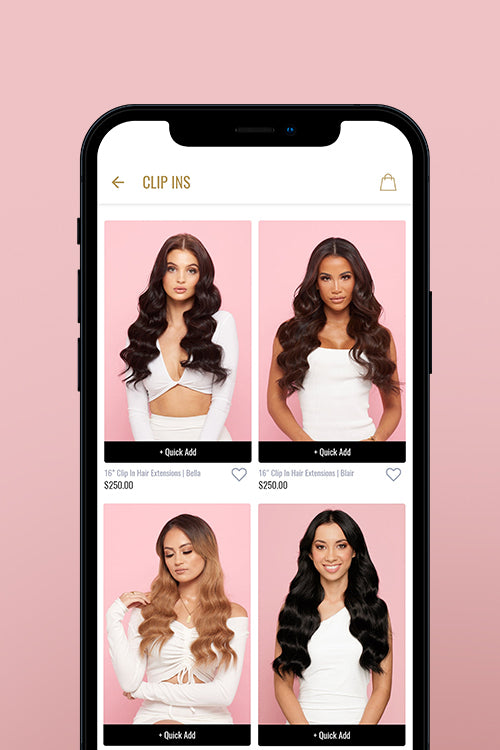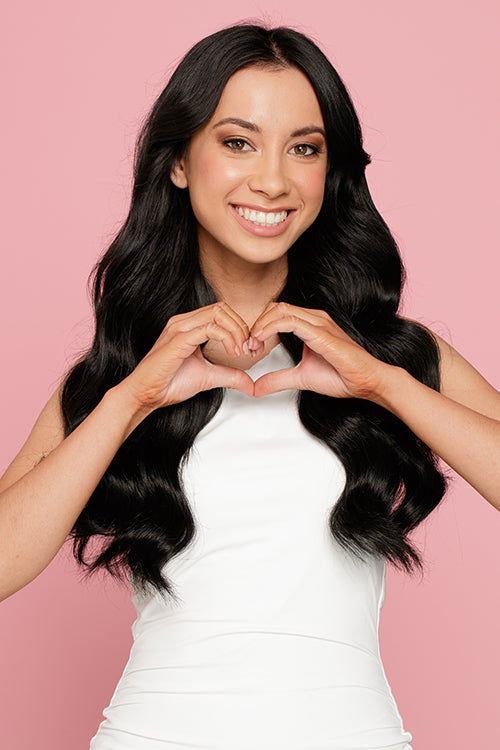How To: Create The Perfect Hair Care Routine
Just like skincare, hair care can be really intimidating and over whelming because there is so many products on the market providing you all sorts of benefits. To simplify things for you we've created the perfect formula to having the perfect hair care routine that goes way further than just knowing how many times to wash your hair.
Let's start with knowing the basics first... the foundation of the perfect hair care routine is knowing the right amount of times to wash your hair throughout the week, how to dry and style it all whilst keeping your hair healthy and luscious. Don't be fooled, you don't need every product on the shelf for your hair care routine - there is more than just your shampoo and conditioner.
First things first - Determining your hair type
When we say hair type, we aren't just referring to the texture of your hair. Other factors in determining your hair type is how well your hair can absorb moisture or how easily your hair breaks will help determine whether you have fine, frizzy, thick, coarse or oily hair. Use the below steps to test from home and learn what your hair type is.
HAIR DENSITY TEST
Hair density is when we refer to how much hair you actually have on your head. Determine your hair density by taking a handful of hair from the front of your head and then gently pull it to the side of your head. If you see a lot of your scalp, this means you have a thin density hair type. However, if you can barely see your scalp, you hair's density is thick. Anything in between those two will be considered medium density.
HAIR DIAMETER TEST
A simple strand test will be able to tell you your diameter. Take on hair strand between your fingertips, if you can't feel the hair between your fingers this is a sign of fine hair. If you DO feel the single strand in your fingertips this is considered medium width or if that hair strand feels thick/textured your hair will be considered coarse.
HAIR ELASTICITY TEST
To test the elasticity of your hair sounds sort of scary but it will tell you straight away what level of elasticity your hair has. Simple take one strand of your hair and see if it stretches or snaps. Your hairs reactions will determine the elasticity and strength of your hair. If you find your hair snapped straight away after pulling it gently between your fingers, your hairs elasticity is low. However, if your hair is able to be stretched, your hairs elasticity is high. Your hairs elasticity helps determine how well your hair can hold any styling. If you have low elasticity hair it is common to find you have thin hair whereas hair with hair elasticity is found in normal to thick hair.
HAIR POROSITY TEST
When you hear hair stylists talking about the porosity of your hair, they are talking about your hairs ability to absorb moisture and product. Test your hairs porosity by filling a bowl with water and place a single strand of hair in the bowl. If you find your hair strand sinks to the bottom, your hair has high porosity which means it's absorbing all the moisture. If your hair strand remains under the surface and floating, your hair is "well balanced" and considered normal porosity. However, if your strand floats above the surface of the water your hair has low porosity which means it does not absorb moisture easily. High porosity hair commonly deals with damaged, dry and frizzy hair whereas low porosity can sometimes feel oily because it takes a lot of product but doesn't distribute or absorb accordingly.
HAIR TEXTURE TEST
This test is a no brainer. Is your hair straight, wavy or curly? Don't forget your hair changes with the seasons, so for example you may have frizzy or curly hair when it's humid but in the colder months you'll find it to be less porous. Slight adjustments in your hair care routine will help battle the seasons and keep your hair healthy all year round.
Now you've taken the tests above, now it's time to gather a list of hair care routine must haves that we recommend and stand by to better the overall health of your hair - because let's be real, we all want beautiful, healthy hair.
YOUR HAIR CARE ROUTINE MUST HAVE THESE ITEMS:
- Shampoo and conditioner
- Microfiber towel (much more gentle on your hair than a regular towel)
- A good quality blow dryer with adjustable heat (the cooler, the better)
- All the curly hair girls absolutely NEED a diffuser
- HEAT PROTECTANT!
- Paddle brush – We recommend a paddle brush because they are great for ALL hair types.
- Dry shampoo
- Scalp massages (5 minutes once or twice a week will do you wonders for hair growth)
- Hair masks (Check out the K18 range)
- Hair oil
So you now know your hair type and the must-have products we recommend having in your hair care routine, now let's determine how often you should be washing your hair throughout the week based on those factors. Ideally, you want to be washing your hair no more than three times a week, this may change depending on your hair type and activity (if you're into sports or the gym etc). Washing your hair too frequently could result in stripping your hair of vital nutrients from your scalp, which is never a good thing. If you have dry hair, we recommend washing your hair twice a week and if you have thick/curly hair washing your hair twice a week will also work. However, if you have oily hair we recommend three times a day which equals up to being every second day.
Something that should always be used in your hair care routine is conditioner. Conditioner is what helps nourish your hair and using shampoo. It's important to apply your conditioner from the mid shafts of your hair to the ends and really massage your conditioner into your hair and leave it in for a few minutes to allow time for your hair to absorb what it can from your conditioner. We say apply your conditioner to the mid-shaft to tips because that's the part of your hair that needs moisture the most, especially if you colour, chemically treat or style your hair regularly. Choosing your shampoo and conditioner should be based on your needs and your hair type. In any and all cases, look for products that are filled with nurturing ingredients that will nourish your hair and absolutely avoid over-using sulphates or avoid using them all together. Sometimes your hair just needs a deep clean and it's not uncommon for deep cleanse shampoos to have sulphates listed in their ingredients.
What More Can I Do In My Hair Care Routine?
You know what products to use and add into your hair care routine but the question is there more you can do in your hair care routine? The answer is yes. For a little tender, love and care we vouch for scalp massages being the perfect way to stimulate hair growth because it circulates oxygen in your scalp which creates healthier hair. In the shower you can do this when you're waiting for your conditioner to settle or with light hair oils that we've listed in this article about how various oils affect hair.
When you're in the shower, keep a watch for the temperature of the water. A hot shower is great for your muscles and your soul it is not however, good for your hair. When washing your hair, use warm water instead when rinsing out your product and if you're game, cold water after conditioner to close the cuticle.
When you're in between washes or find you're short on time, dry shampoo is your best friend and should definitely be in your hair care routine. Dry shampoo should be applied to the roots and then distributed evenly throughout your hair. Trick tip: apply dry shampoo to a paddle brush first and then brush it directly into your hair to guarantee you're hitting all the spots.
Lastly, hair masks and conditioning treatments are a must! Especially if your colour, chemically treat or have dry hair. Treat yourself to a professional conditioning treatment once a month or DIY it from home. Again, depending on your hair needs will determine what sort of mask your hair will need to be healthy and strong.
Drying And Styling Your Hair
You know how to wash your hair and the products you need, but what about drying your hair the best way possible? We recommend using a microfibre towel because they are gentler on your hair, also avoid rubbing your hair too vicariously to protect your hair. When you are blow drying your hair, make sure you are using a heat protectant to protect your hair as well. We sound like a broken record, we know but heat protectant is the number one important thing in your hair care routine if you use heated styling tools. If you can air dry your hair, apply a light serum or light leave in conditioner whilst around the house instead of using a blow dryer to dry your locks.
ADD HAIR EXTENSIONS INTO YOUR HAIR CARE ROUTINE
If you're wanting to grow your hair or add thickness, hair extensions are here for you! We are here for you. We recommend using temporary style hair extensions such as clip in extensions, halo hair extensions or ponytails. Hair extensions are great for encouragement when soldiering on in your hair growth journey without any additional hair loss or trauma to your hair.
Building your hair care routine is all about firstly determining your hair type and then your hair needs to then treat your hair. It doesn't have to over complicated as we said in the beginning but knowing products that will help give you healthy strong hair will go a long way. Just remember; wash, dry, style and treatment are all important when creating a hair care routine that's ideal for you. Cheers to healthy hair babe!










Leave a comment